Drought Forecasting with Vegetation Temperature Condition Index Using ARIMA Models in the Guanzhong Plain
Abstract
:1. Introduction
2. Study Area and Methodology
2.1. Study Area
2.2. Vegetation Tempreture Condition Index
2.2.1. Composition of the NDVI and LST products
2.2.2. VTCI calculations
2.3. SARIMA Model
2.4. SARIMA Modeling Procedure
2.4.1. Identification
2.4.2. Estimation
2.4.3. Diagnostic Checking
2.5. Data Processing
3. Results
4. Discussion
4.1. Evaluating the Models Using Statistical Analysis
4.2. Evaluating the Models Using Drought Categories
5. Conclusions
Acknowledgments
Author Contributions
Conflicts of Interest
Abbreviations
| VTCI | Vegetation Temperature Condition Index |
| SARIMA | Seasonal AutoRegressive Integrated Moving Average |
| NDVI | Normalized Difference Vegetation Index |
| LST | Land Surface Temperature |
| ACF | AutoCorrelation Function |
| SPI | Standardize Precipitation Index |
| PDSI | Palmer Drought Severity Index |
| AVHRR | Advanced Very High Resolution Radiometer |
| NOAA | National Oceanic and Atmospheric Administration |
| VCI | Vegetation Condition Index |
| SVI | Standardized Vegetation Index |
References
- Valipour, M. Optimization of neural networks for precipitation analysis in a humid region to detect drought and wet year alarms. Meteorol. Appl. 2015, 23, 91–100. [Google Scholar] [CrossRef]
- Mishra, A.K.; Singh, V.P. A review of drought concepts. J. Hydrol. 2010, 391, 204–216. [Google Scholar] [CrossRef]
- Bravar, L.; Kavvas, M.L. On the physics of drought. I. A conceptual framework. J. Hydrol. 1991, 129, 281–297. [Google Scholar] [CrossRef]
- Mckee, T.B.; Doesken, N.J.; Kleist, J. The relationship of drought frequency and duration to time scales. In Proceedings of the Eighth Conference on Applied Climatology, Anaheim, CA, USA, 17–22 January 1993; pp. 179–184.
- Palmer, W.C. Meteorological Drought; Research Paper No. 45; U.S. Weather Bureau: Washington, DC, USA, 1965.
- Rahimi, S.; Sefidkouhi, M.A.G.; Raeini-Sarjaz, M.; Valipour, M. Estimation of actual evapotranspiration by using MODIS images (a case study: Tajan catchment). Arch. Agron. Soil Sci. 2014, 61, 1–15. [Google Scholar] [CrossRef]
- Bao, G.; Qin, Z.H.; Bao, Y.H.; Zhou, Y.; Li, W.J.; SantheJjav, A. NDVI-based long-term vegetation dynamics and its response to climatic change in Mongolian Plateau. Remote Sens. 2014, 6, 8337–8358. [Google Scholar] [CrossRef]
- Karnieli, A.; Shachak, M.; Tsoar, H.; Zaady, E.; Kaufman, Y.; Danin, A.; Porter, W. The effect of microphytes on the spectral reflectance of vegetation in semiarid regions. Remote Sens. Environ. 1996, 57, 88–96. [Google Scholar] [CrossRef]
- Bayarjargal, Y.; Karnieli, A.; Bayasgalan, M.; Khudulmur, S.; Gandush, C.; Tucker, C.J. A comparative study of NOAA-AVHRR derived drought indices using change vector analysis. Remote Sens. Environ. 2006, 105, 9–22. [Google Scholar] [CrossRef]
- Tucker, C.J. Comparing SMMR and AVHRR data for drought monitoring. Int. J. Remote Sens. 1989, 10, 1663–1672. [Google Scholar] [CrossRef]
- Maselli, F.; Conese, C.; Petkov, L.; Gilabert, M.A. Environmental monitoring and crop forecasting in the Sahel through the use of NOAA NDVI data. A case study: Niger 1986–89. Int. J. Remote Sens. 1993, 14, 3471–3487. [Google Scholar] [CrossRef]
- Zhu, X.F.; Zhao, A.Z.; Li, Y.Z.; Liu, X.F. Agricultural irrigation requirements under future climate scenarios in China. J. Arid Land 2015, 7, 224–237. [Google Scholar] [CrossRef]
- Schmidt, H.; Karnieli, A. Remote sensing of the seasonal variability of vegetation in a semi-arid environment. J. Arid Environ. 2000, 45, 43–59. [Google Scholar] [CrossRef]
- Wu, G.; Liu, Y. Satellites-based detection of water surface variation in China’s largest freshwater lake in response to hydro-climatic drought. Int. J. Remote Sens. 2014, 35, 4544–4558. [Google Scholar] [CrossRef]
- Kumar, S.V.; Peterslidard, C.D.; Mocko, D.; Reichle, R.; Liu, Y.Q.; Arsenault, K.R.; Xia, Y.L.; Ek, M.; Riggs, G.; Livneh, B.; et al. Assimilation of remotely sensed soil moisture and snow depth retrievals for drought estimation. J. Hydrometeorol. 2014, 15, 2446–2469. [Google Scholar] [CrossRef]
- Malingreau, J.P. Global vegetation dynamics: Satellite observations over Asia. Int. J. Remote Sens. 1986, 7, 1121–1146. [Google Scholar] [CrossRef]
- Tucker, C.J.; Choudhury, B.J. Satellite remote-sensing of drought conditions. Remote Sens. Environ. 1987, 23, 243–251. [Google Scholar] [CrossRef]
- Srivastava, S.K.; Jayaraman, V.; Rao, P.P.N.; Manikiam, B.; Chandrasekhar, M.G. Interlinkages of NOAA/AVHRR derived integrated NDVI to seasonal precipitation and transpiration in dryland tropics. Int. J. Remote Sens. 1997, 18, 2931–2952. [Google Scholar] [CrossRef]
- Liu, W.T.; Juarez, R.I.N. ENSO drought onset prediction in northeast Brazil using NDVI. Int. J. Remote Sens. 2001, 22, 3483–3501. [Google Scholar] [CrossRef]
- Ji, L.; Peters, A.J. Assessing vegetation response to drought in the northern Great Plains using vegetation and drought indices. Remote Sens. Environ. 2003, 87, 85–98. [Google Scholar] [CrossRef]
- Kogan, F.N. Remote sensing of weather impacts on vegetation in non-homogeneous areas. Int. J. Remote Sens. 1990, 11, 1405–1419. [Google Scholar] [CrossRef]
- Peters, A.J.; Waltershea, E.A.; Ji, L.; Vina, A.; Hayes, M.; Svoboda, M.D. Drought monitoring with NDVI-based standardized vegetation index. Photogramm. Eng. Remote Sens. 2002, 68, 71–75. [Google Scholar]
- Gutman, G.G. Towards monitoring droughts from space. J. Clim. 1990, 3, 282–295. [Google Scholar] [CrossRef]
- Wan, Z.M.; Wang, P.X.; Li, X.W. Using MODIS land surface temperature and normalized difference vegetation index products for monitoring drought in the southern Great Plains, USA. Int. J. Remote Sens. 2004, 25, 61–72. [Google Scholar] [CrossRef]
- Sun, W.; Wang, P.X.; Zhang, S.Y.; Zhu, D.H.; Liu, J.M.; Chen, J.H.; Yang, H.S. Using the vegetation temperature condition index for time series drought occurrence monitoring in the Guanzhong Plain, PR China. Int. J. Remote Sens. 2008, 29, 5133–5144. [Google Scholar] [CrossRef]
- Goetz, S.G. Multi-sensor analysis of NDVI, surface temperature and biophysical variables at a mixed grassland site. Int. J. Remote Sens. 1997, 18, 71–94. [Google Scholar] [CrossRef]
- Nemani, R.R.; Pierce, L.L.; Running, S.W.; Goward, S.N. Developing satellite derived estimates of surface moisture status. J. Appl. Meteorol. 1993, 28, 276–284. [Google Scholar] [CrossRef]
- Price, J.C. Using spatial context in satellite data to infer regional scale evapotranspiration. IEEE Trans. Geosci. Remote Sens. 1990, 28, 940–948. [Google Scholar] [CrossRef]
- Carlson, T.N.; Gillies, R.R.; Perry, E.M. A method to make use of thermal infrared temperature and NDVI measurements to infer soil water content and fractional vegetation cover. Remote Sens. Reviews. 1994, 9, 161–173. [Google Scholar] [CrossRef]
- Gillies, R.R.; Carlson, T.N. Thermal remote sensing of surface soil water content with partial vegetation cover for incorporating into climate models. J. Appl. Meteorol. 1995, 34, 745–756. [Google Scholar] [CrossRef]
- Gillies, R.R.; Carlson, T.N.; Cui, J.; Kustas, W.P.; Humes, K.S. A verification of the “triangle” method for obtaining surface soil water content and energy fluxes from remote measurements of the Normalized Difference Vegetation Index (NDVI) and surface radiant temperature. Int. J. Remote Sens. 1997, 18, 3145–3166. [Google Scholar] [CrossRef]
- Moran, M.S.; Clarke, T.R.; Inoue, U.; Vidal, A. Estimating crop water deficit using the relation between surface-air temperature and spectral vegetation index. Remote Sens. Environ. 1994, 49, 246–263. [Google Scholar] [CrossRef]
- Yang, X.; Zhou, Q.; Melville, M. Estimating local sugarcane evapotranspiration using Landsat TM image and a VITT concept. Int. J. Remote Sens. 1997, 18, 453–459. [Google Scholar] [CrossRef]
- Jackson, R.D.; Idso, S.B.; Reginato, R.J.; Pinter, P.J., Jr. Canopy temperature as a crop water stress indicator. Water Resour. Res. 1981, 17, 1133–1138. [Google Scholar] [CrossRef]
- Kogan, F.N. Application of vegetation index and brightness temperature for drought detection. Adv. Space Res. 1995, 15, 91–100. [Google Scholar] [CrossRef]
- Wang, P.X.; Gong, J.Y.; Li, X.W. Vegetation temperature condition index and its application for drought monitoring. Geomat. Inf. Sci. Wuhan Univ. 2001, 26, 412–418. [Google Scholar]
- Sandholt, I.; Rasmussen, K.; Anderson, J. A simple interpretation of the surface temperature/vegetation index space for assessment of the surface moisture status. Remote Sens. Environ. 2002, 79, 213–224. [Google Scholar] [CrossRef]
- Lin, Q.; Wang, P.X.; Zhang, S.Y.; Li, L.; Jing, Y.G.; Liu, J.M. Applicability of vegetation temperature index for drought monitoring at different time scales. Arid Zone Res. 2016, 33, 186–192. [Google Scholar]
- Zhang, S.Y.; Sun, W.; Wang, P.X. Classification of drought grades based on vegetation temperature condition index. Arid Zone Res. 2010, 27, 600–606. [Google Scholar]
- Wang, M.C.; Yang, S.T.; Dong, G.T.; Bai, J. Estimating soil water in northern China based on vegetation temperature condition index (VTCI). Arid Land Geogr. 2012, 35, 446–455. [Google Scholar]
- Lohani, V.K.; Loganathan, G.V. An early warning system for drought management using the Palmer drought index. J. Am. Water Resour. Assoc. 1997, 33, 1375–1386. [Google Scholar] [CrossRef]
- Rao, A.R.; Padmanabhan, G. Analysis and modeling of Palmer Drought Index series. J. Hydrol. 1984, 68, 211–229. [Google Scholar] [CrossRef]
- Sen, Z. Critical drought analysis by 2nd-order Markov-chain. J. Hydrol. 1990, 120, 183–202. [Google Scholar] [CrossRef]
- Kim, T.W.; Valdes, J.B. Nonlinear model for drought forecasting based on a conjunction of wavelet transforms and neural networks. J. Hydrol. Eng. 2003, 8, 319–328. [Google Scholar] [CrossRef]
- Box, G.E.P.; Jenkins, G.M.; Reinsel, G.C. Time Series Analysis. Forecasting and Control; Prentice Hall: Englewood Cliffs, NJ, USA, 1970. [Google Scholar]
- Godfrey, G.A.; Powell, W.B. Adaptive estimation of daily demands with complex calendar effects for freight transportation. Transp. Res. B Method 2000, 34, 451–469. [Google Scholar] [CrossRef]
- Valipour, M. Long-term runoff study using SARIMA and ARIMA models in the United States. Meteorol. Appl. 2015, 22, 592–598. [Google Scholar] [CrossRef]
- Valipour, M.; Banihabib, M.E.; Behbahani, S.M.R. Comparison of ARMA, ARIMA and the autoregressive artificial neural network models in forecasting the monthly inflow of Dez dam reservoir. J. Hydrol. 2013, 476, 433–441. [Google Scholar] [CrossRef]
- Pappas, S.S.; Ekonomou, L.; Moussas, V.C.; Karampelas, P.; Katsikas, S.K. Adaptive load forecasting of the Hellenic electric grid. J. Zhejiang Univ. Sci. A 2008, 9, 1724–1730. [Google Scholar] [CrossRef]
- Han, P.; Wang, P.X.; Zhang, S.Y.; Zhu, D.H. Drought forecasting based on the remote sensing data using ARIMA models. Math. Comput. Model. 2010, 51, 1398–1403. [Google Scholar] [CrossRef]
- Shumway, R.H.; Stoffer, D.S. An approach to time series smoothing and forecasting using the EM algorithm. J. Time Ser. Anal. 1982, 3, 253–264. [Google Scholar] [CrossRef]
- Akaike, H. A new look at the statistical model identification. IEEE Trans. Autom. Control. 1974, 19, 716–737. [Google Scholar] [CrossRef]
- Niemann, K.O.; Quinn, G.; Goodenough, D.G.; Visintini, F.; Loos, R. Addressing the effects of canopy structure on the remote sensing of foliar chemistry of a 3-Dimensional, radiometrically porous surface. IEEE J. Sel. Top. Appl. Earth Obs. Remote Sens. 2012, 5, 584–593. [Google Scholar] [CrossRef]
- Boor, C.D. A Practical Guide to Splines; Springer-Verlag: New York, NY, USA, 1978. [Google Scholar]
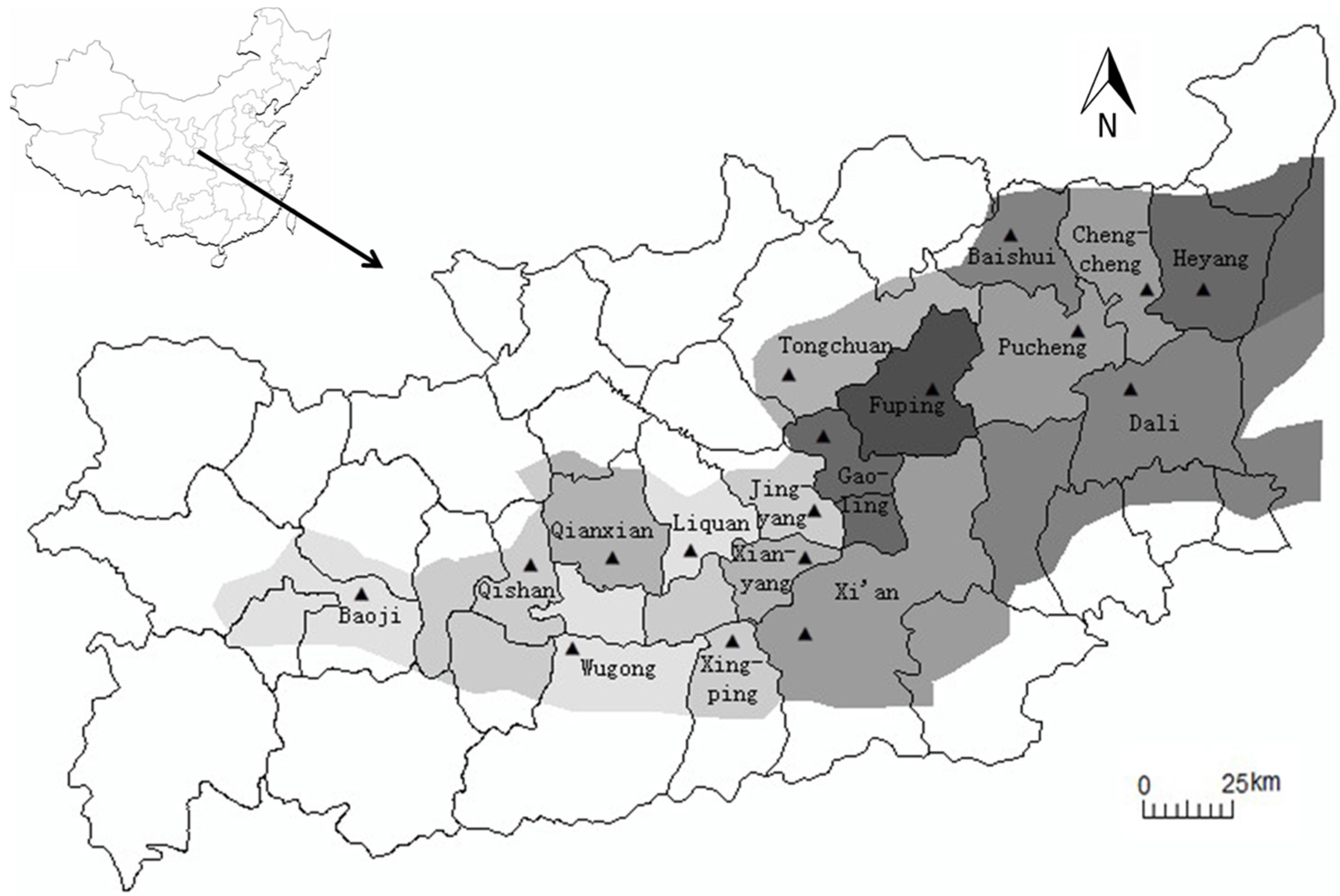

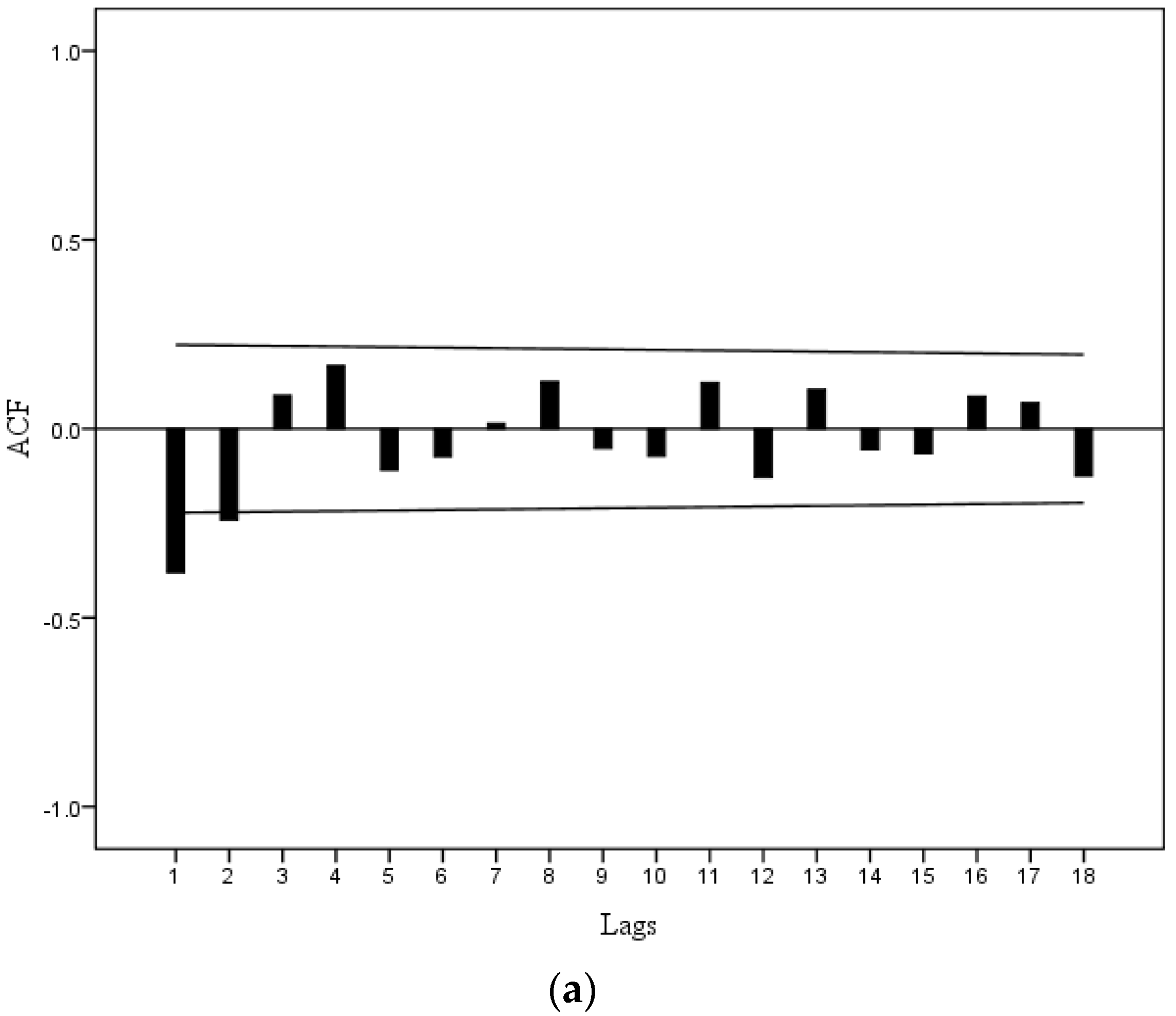
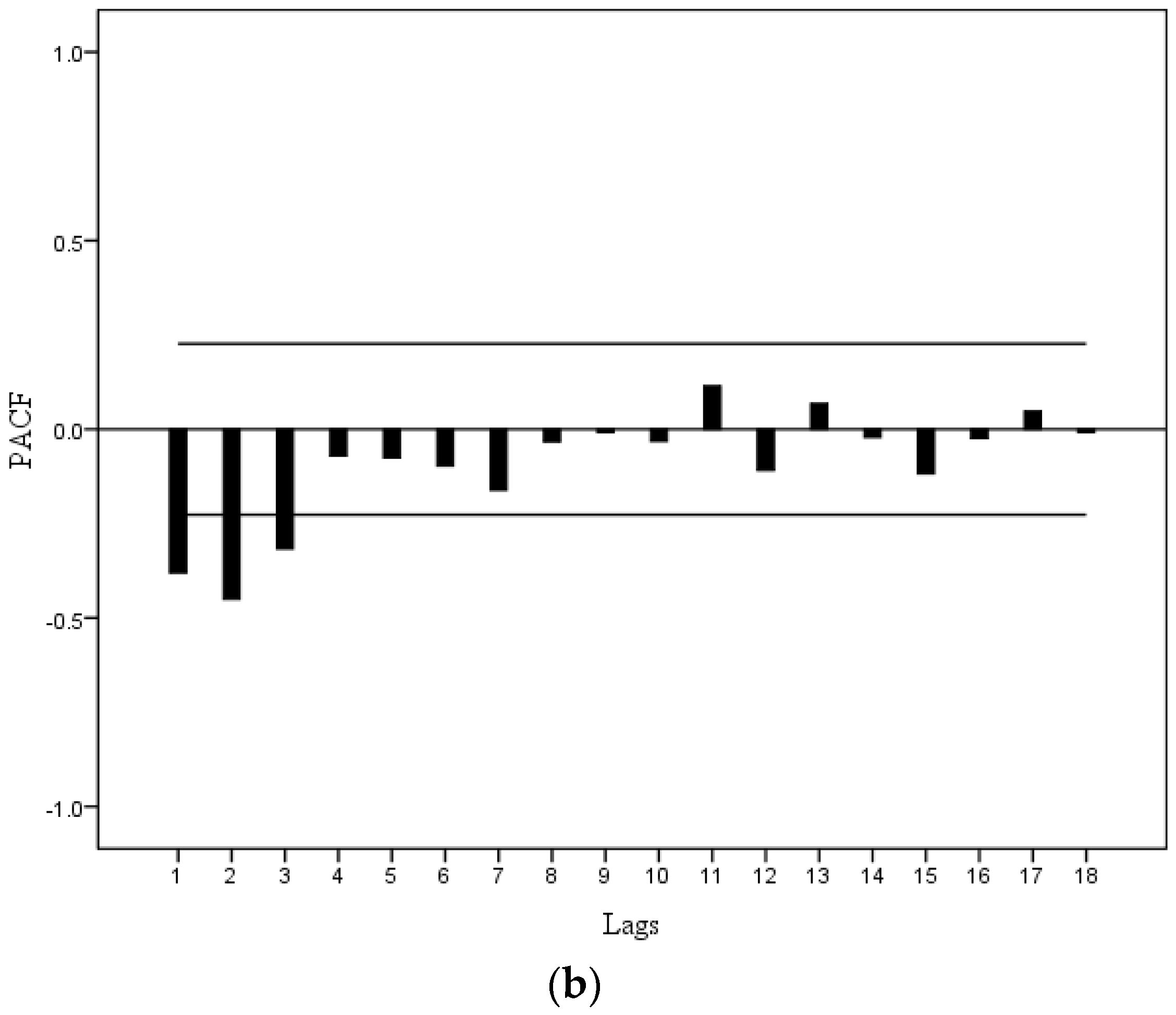
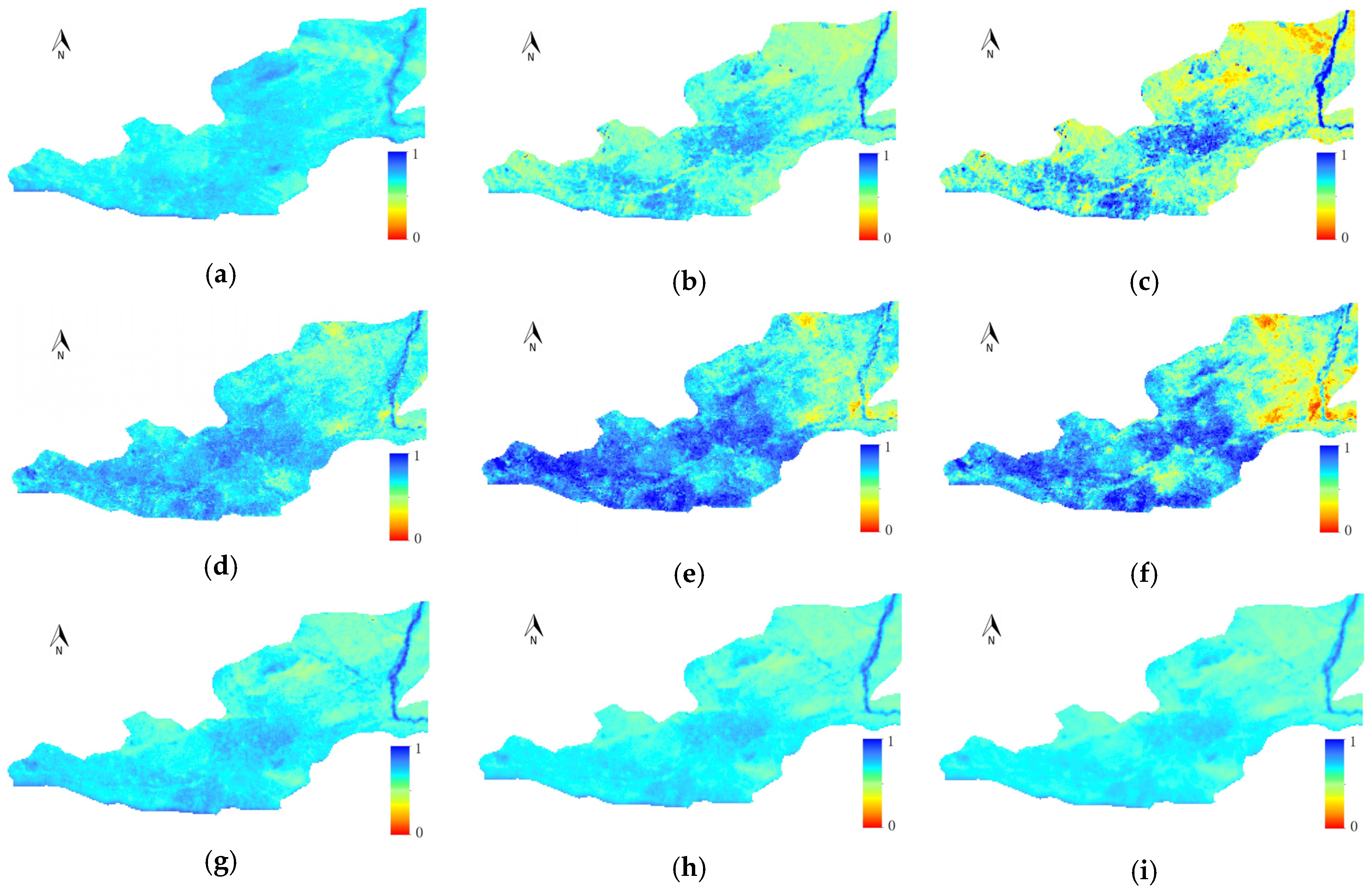
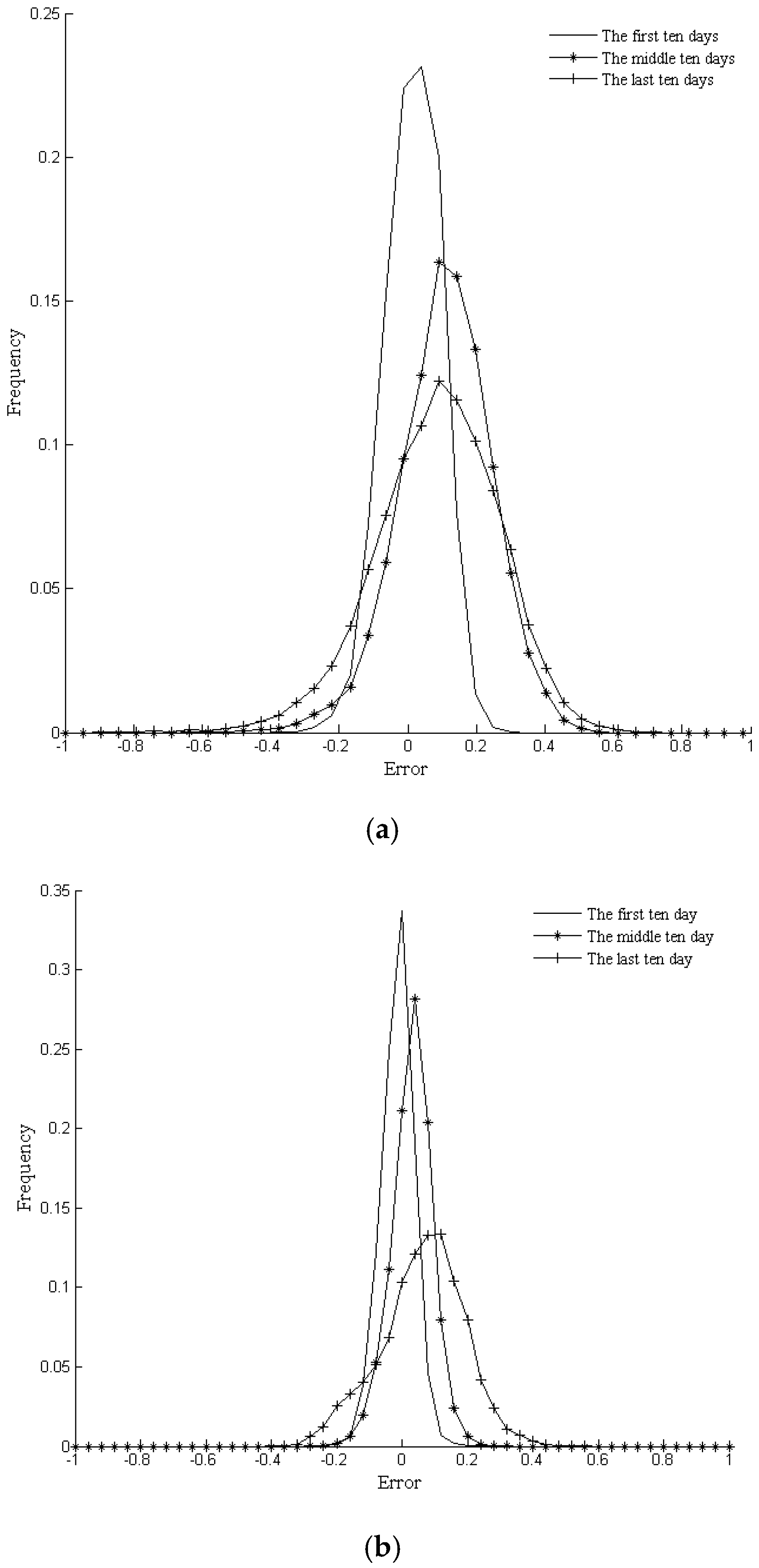

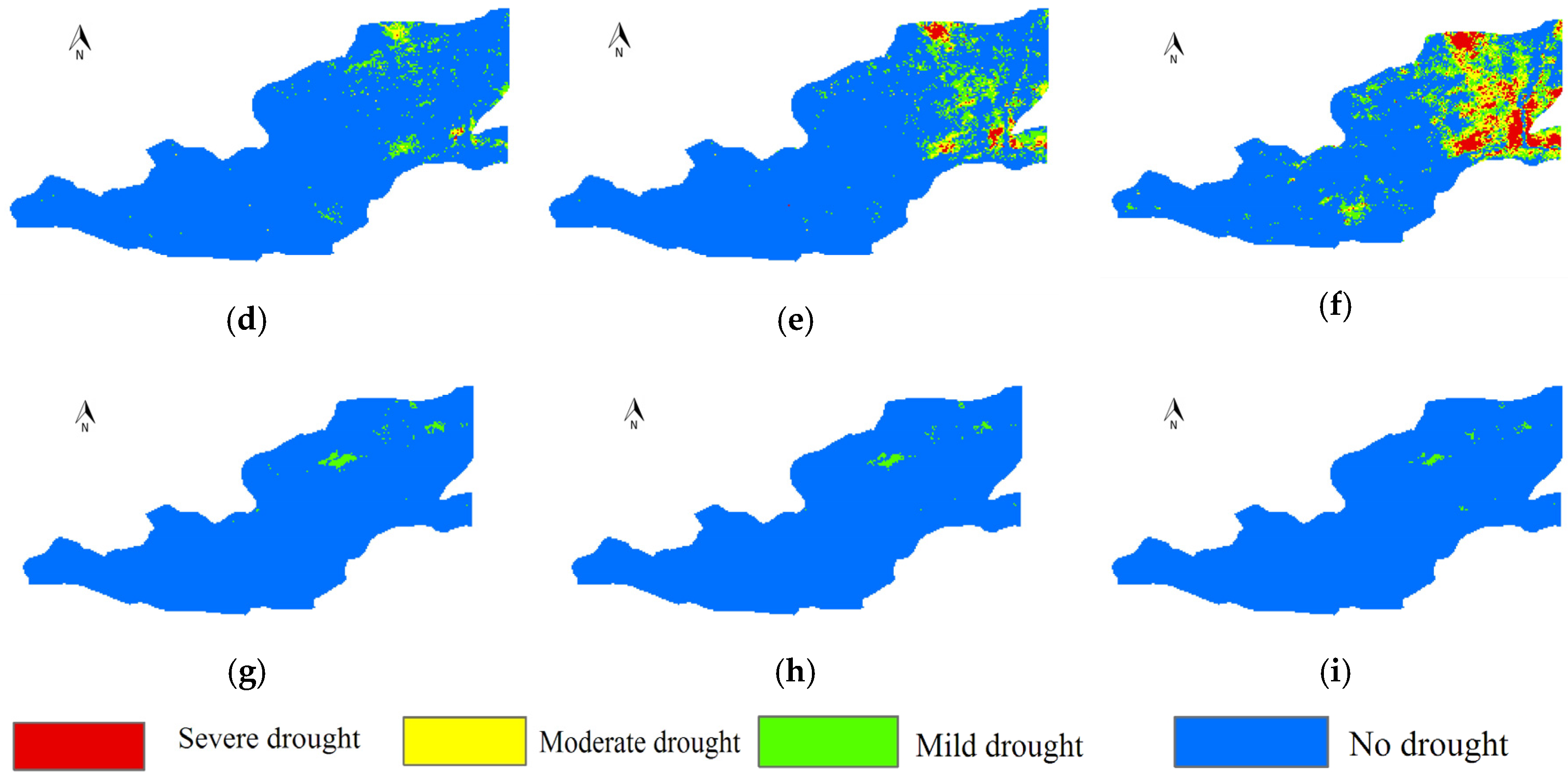
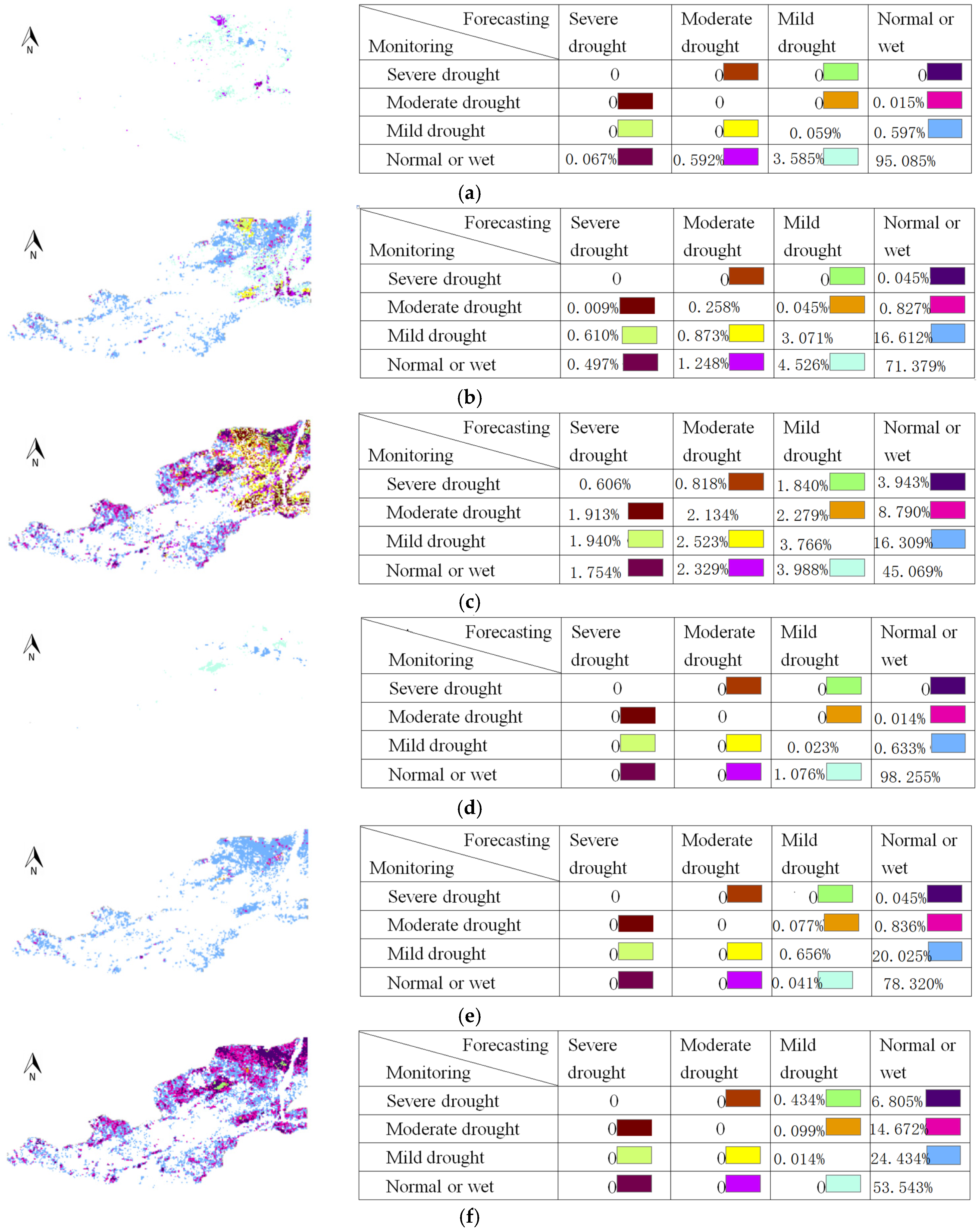
| 0 | 1 | 2 | |
|---|---|---|---|
| 0 | −36.34 | −34.37 | −36.48 |
| 1 | −34.37 | −40.45 | −39.39 |
| 2 | −35.45 | −35.23 | −37.78 |
| 3 | −34.69 | −33.34 | −38.64 |
| Lag | Autocorrelation | ||||
|---|---|---|---|---|---|
| 1–5 | 0.041 | −0.071 | 0.010 | −0.115 | 0.057 |
| 6–10 | 0.189 | −0.079 | 0.053 | 0.097 | −0.176 |
| 11–15 | −0.075 | 0.003 | −0.040 | 0.191 | 0.166 |
| 16–20 | −0.143 | −0.073 | −0.068 | −0.032 | −0.010 |
| 21–25 | 0.051 | −0.090 | 0.075 | −0.019 | −0.059 |
| Name of Station | Name of Station | Name of Station | ||||||
|---|---|---|---|---|---|---|---|---|
| Liquan | 0 | 1 | Xianyang | 2 | 1 | Heyang | 1 | 1 |
| Baishui | 2 | 1 | Gaoling | 2 | 1 | Pucheng | 1 | 1 |
| Baoji | 2 | 0 | Jingyang | 2 | 1 | Fuping | 1 | 1 |
| Xi’an | 2 | 1 | Chengcheng | 1 | 1 | Qianxian | 1 | 1 |
| Wugong | 2 | 1 | Dali | 1 | 1 | Tongchuan | 1 | 1 |
| Xingping | 2 | 1 | Qishan | 1 | 1 |
| Model | Step | Range | Average | RMSE |
|---|---|---|---|---|
| SARIMA | 1 | −0.3608–0.3137 | 0.0243 | 0.0818 |
| AR(1) | 1 | −0.2353–0.2392 | −0.0047 | 0.0513 |
| SARIMA | 2 | −0.6275–0.5725 | 0.1194 | 0.1745 |
| AR(1) | 2 | −0.2980–0.3333 | 0.0412 | 0.0697 |
| SARIMA | 3 | −0.8706–0.7020 | 0.0961 | 0.2004 |
| AR(1) | 3 | −0.3843–0.5725 | 0.0730 | 0.1414 |
| Drought Category | VTCI Value |
|---|---|
| Normal or wet | >0.55 |
| Mild drought | 0.46–0.55 |
| Moderate drought | 0.37–0.46 |
| Severe drought | <0.37 |
© 2016 by the authors; licensee MDPI, Basel, Switzerland. This article is an open access article distributed under the terms and conditions of the Creative Commons Attribution (CC-BY) license (http://creativecommons.org/licenses/by/4.0/).
Share and Cite
Tian, M.; Wang, P.; Khan, J. Drought Forecasting with Vegetation Temperature Condition Index Using ARIMA Models in the Guanzhong Plain. Remote Sens. 2016, 8, 690. https://doi.org/10.3390/rs8090690
Tian M, Wang P, Khan J. Drought Forecasting with Vegetation Temperature Condition Index Using ARIMA Models in the Guanzhong Plain. Remote Sensing. 2016; 8(9):690. https://doi.org/10.3390/rs8090690
Chicago/Turabian StyleTian, Miao, Pengxin Wang, and Jahangir Khan. 2016. "Drought Forecasting with Vegetation Temperature Condition Index Using ARIMA Models in the Guanzhong Plain" Remote Sensing 8, no. 9: 690. https://doi.org/10.3390/rs8090690
APA StyleTian, M., Wang, P., & Khan, J. (2016). Drought Forecasting with Vegetation Temperature Condition Index Using ARIMA Models in the Guanzhong Plain. Remote Sensing, 8(9), 690. https://doi.org/10.3390/rs8090690






